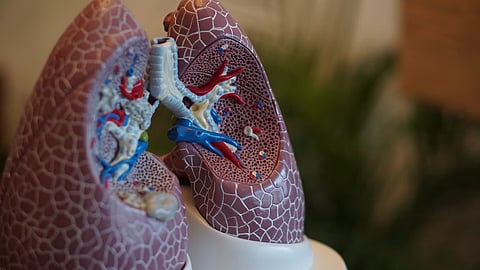
- Home
- न्यूजग्राम
- NewsGram USA
- India
- World
- Politics
- Entertainment
- Culture
- Lifestyle
- Economy
- Sports
- Sp. Coverage
- Misc.
- NewsGram Exclusive
- Jobs / Internships

By: Sunil Kumar Jha
Respiratory protection has gained significant headlines over the past few years, largely due to the onslaught of the COVID-19 pandemic. Prominently, disposable masks became trendier during the pandemic, prompting companies to augment their production capacity. The prevalence of infectious and deadly diseases, such as the Ebola virus and COVID-19, has spurred the use of Respiratory Protective Equipment (RPE). Global demand for Personal Protective Equipment (PPE), including RPE led to an unprecedented procurement by governments and other stakeholders, intensifying the competition for PPE. Fortune Business Insights™ estimates the market for respiratory protective equipment to touch USD 10.97 billion by 2028.
In common parlance, respiratory protective equipment protects the wearer against the inhalation of hazardous substances in the workplace air. Respiratory disorders could develop due to improper use of RPE. They could be chronic and fatal in some cases. According to the Health and Safety Executive (HSE), around 12,000 deaths each year are attributed to occupational respiratory diseases. So, what has prompted potential abstinence from wearing respiratory protection? One of the reasons may be that the equipment was uncomfortable. It can lead the individual wearer to not wear the equipment properly, thereby minimizing the level of protection provided by respiratory protective equipment. Therefore, major respiratory protection equipment manufacturers could emphasize innovations and technological advancements.
Air-purifying Respirators Gain Ground
Exponential demand for disposable masks, including surgical masks and N95 masks has prompted respiratory protective equipment manufacturers to augment the production of Air-Purifying Respirators (APRs). These respirators work by removing vapors, gases, and aerosols through the use of cartridges, filters, and canisters. The equipment may consist of half or full facepieces and should be worn for high-risk aerosol-generating procedures. Some of the insights into APRs are delineated below:
Ø Powered Air-Purifying Respirator (PAPR): These respirators can be used to protect against particles, vapors, and gases. They are reusable components and battery-powered with a blower. PAPR could be selected if the N95 respirator choices are unavailable or the wearers have facial deformities and facial hair.
Ø Elastomeric Full Facepiece Respirator: The equipment is reusable and can be used to protect against vapors, gases or particles. It could be a more effective face seal vis-à-vis filtering facepiece respirator.
Healthcare & Pharmaceuticals Remain Valuable Proposition
There is no denying that healthcare professionals are exposed to various body fluid contamination, blood, and chemicals. Some hazards, including drug exposure, biological hazards, respiratory hazards, blood-borne pathogens, waste anesthetic gas exposure, and laser hazards have prompted manufacturers to infuse funds into advanced respiratory protective equipment.
Considering the urbanization and industrialization trend, RPE manufacturers and suppliers have prioritized the need for protective equipment in the healthcare vertical.
Emergence of Protective Equipment in Oil & Gas Companies
An increased number of oil & gas extraction workers has succumbed to a host of hazards in this sector. Oil & gas products and chemicals could be corrosive, irritating, and flammable. Oil & gas wells tend to get workers exposed to hydrogen sulfide gas. Air purifying respirators have cartridges designed to filter airborne particles and chemicals, including acid gases and organic vapors. The use of full-face respirators, gas monitors, self-contained breathing apparatus, and portable air sources has gained considerable traction.
Supplied Air Respirators (SARs) have become highly sought-after across major economies, largely due to their ability to make an emergency escape from the Immediately Dangerous to Life and Health (IDLH) site possible. Moreover, air purifying respirators could be less effective, owing to contaminants and lack of oxygen. SARs are warranted in workplaces where:
Chemicals are poorly absorbed in the atmosphere
Airborne contaminants fail to emit detectable odor taste
Airborne contaminants exceed the approved limit for an air-purifying respirator
Oil & gas industry workers assess the task and determine the duration of use when choosing equipment, considering the amount of breathable air they need throughout the use.
Regulatory Bodies Rise their Efforts
Regulatory bodies, including OSHA, EPA, and NIOSH have increased their efforts to boost workplace safety. Industries are expected to have a detailed hazard assessment and comply with OSHA’s Respiratory Protection Standard 29 CFR 1910.134 and OSHA’s Toxic and Hazardous Substances Standard 29 CFR 1910.1000.
Surgical and N95 masks have become mega-trends among workers and employees across industry verticals. In doing so, employee safety training programs, along with bullish government policies, will gain momentum. Furthermore, regulatory bodies could boost their testing capacity and solidify their quality management system.
(About the Author:Sunil Kumar Jha has been a part of the content industry for four years. He focuses on penning down articles across various topics, spanning from business and technology to trade, finance, and the English language. Sunil brings forth the expertise of intensive research and a strategic approach in his pieces. He is pursuing Masters in Journalism and Mass Communication)
